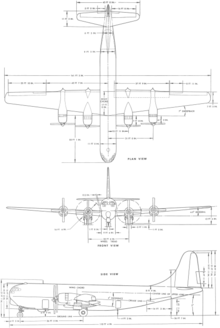Boeing C-97 Stratofreighter
All nine were based on the 24ST alloy structure and Wright R-3350 engines of the B-29, but with a larger-diameter fuselage upper lobe (making a figure of eight or "double-bubble" section) and they had the B-29 vertical tail with the gunner's position blanked off.The first of three heavily revised YC-97A incorporating the re-engineered wing (higher-strength 75ST alloy), taller vertical tail and larger Pratt & Whitney R-4360 engines of the B-50 bomber, flew on 28 January 1948 and was the basis of the subsequent sole YC-97B, all production C-97s, KC-97s and civilian Stratocruiser aircraft.On 9 January 1945, the first prototype, piloted by Major Curtin L. Reinhardt, flew from Seattle to Washington, D.C. in 6 hours 4 minutes, an average speed of 383 mph (616 km/h) with 20,000 lb (9,100 kg) of cargo.The tenth and all subsequent aircraft were fitted with the 3,500 hp (2,600 kW) Pratt & Whitney Wasp Major engines and taller fin and rudder of the B-50 Superfortress.The C-97 was developed into the civilian Boeing 377 Stratocruiser, a transoceanic airliner that could be fitted with sleeper cabins and featured a lower deck lounge.[8][9] The following Air Force wing organizations flew the various C-97 models at some time during their existence:[15] – Westchester County Airport, New York (1962–1969) Data from Boeing C-97 Stratofreighter[34][35][36]General characteristics Performance







Military transport aircraftManufacturerBoeingUnited States Air ForceIsraeli Air ForceBoeing B-29 SuperfortressBoeing B-50 SuperfortressBoeing KC-97 StratofreighterBoeing 377 StratocruiserAero Spacelines Pregnant GuppyAero Spacelines Super GuppyAero Spacelines Mini GuppyWright R-3350Pratt & Whitney R-4360Korean WarVietnam WarStrategic Air CommandWorld War IIB-29 SuperfortressPhilip G. JohnsonSeattleWashington, D.C.Pratt & Whitney Wasp MajorB-50 Superfortresstactical airlifter2½-ton trucksM56 ScorpionDouglas C-124 Globemaster IIBoeing KC-135 StratotankerBerlin AirliftBiafran airliftUli airstripBiafraNigerian Civil WarMinnesotaMilitary Airlift CommandSA-2 GuidelineSuez Canalaerial refuelingWest Berlin Air CorridorGeneral Electric J47-GE-23Pratt & Whitney YT34-P-5turbopropsIsraelSpanish Air ForceUnited States105th Aeromedical Transport GroupWestchester County AirportNew York106th Air Transport GroupSuffolk County Airport109th Air Transport GroupSchenectady Airport111th Air Transport GroupNAS Willow GrovePennsylvania116th Air Transport GroupDobbins ARBGeorgia118th Air Transport GroupBerry Field Air National Guard BaseNashville International AirportTennessee126th Air Refueling WingO'Hare AirportIllinois128th Air Refueling WingGen. Mitchell AirportWisconsin133d Air Transport WingMinneapolis-St Paul International Airport137th Air Transport GroupWill Rogers World AirportOklahoma138th Air Transport GroupTulsa Air National Guard BaseTulsa International Airport139th Air Transport GroupRosecrans Air National Guard BaseMissouri180th Air Transport Squadron (Heavy)146th Air Transport WingVan Nuys Air National Guard BaseVan Nuys AirportCalifornia151st Air Transport WingSalt Lake City Air National Guard BaseSalt Lake City International Airport157th Air Transport GroupNew HampshirePease AFB161st Air Transport GroupSky Harbor International AirportArizona162d Air Transport Wing164th Air Transport GroupMemphis Air National Guard BaseMemphis International Airport165th Air Transport GroupSavannah Air National Guard BaseSavannah International Airport166th Air Transport GroupNew Castle Air National Guard BaseGreater Wilmington AirportDelawareLong Beach AirportBalairZantop Air TransportWright-Patterson Air Force BaseKelly Air Force BaseLajes FieldMilitary Air Transport ServiceWestover Air Force BasePacific OceanKwajaleincargo airlineMexico City-Toluca highwayCalifornia Air National GuardMilestones of Flight MuseumFox FieldLancaster, CaliforniaIsraeli Air Force MuseumHatzerim AirbaseBeershebaFarmingdale, New JerseyPima Air & Space Museum